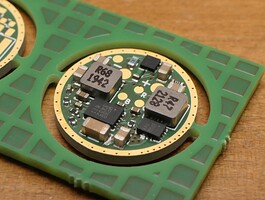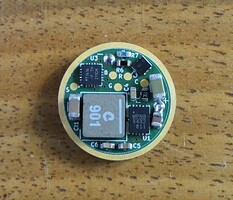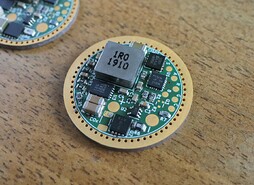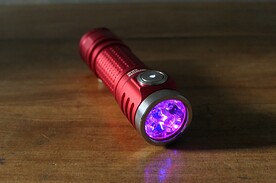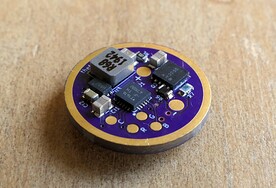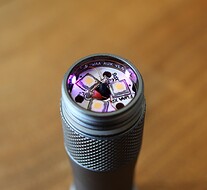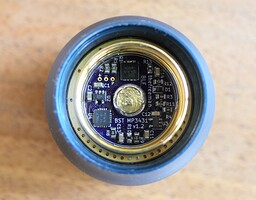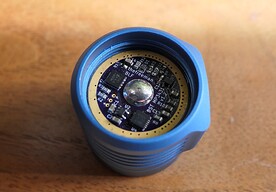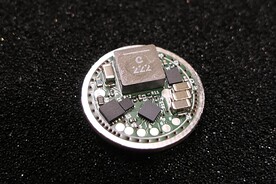-
2022/12 : FWxAA 3V boost-buck driver
-
2022/09 : FWAA NiMH/li-ion boost driver
-
2022/09 : FF PL09 Quad build
-
2022/08 : BST15/BST18/BST21 HDR/DAC 40W boost drivers with efficiency measurements
-
2021/11 : FWAA with 6A buck driver
-
2021/11 : Gchart DAC control implementation, Vref switching, smooth range transition, lower component count.
-
2021/10 : Buck driver
-
2021/09-10 : KR1 build and D4V2 build
-
2021/08 : New layout, problem with low output whine with TPS61288 and switch to MP3431
Reserved
Big IN!
Looking good freeman :)
Thanks for doing this. ![]() While this may be a bit redundant with what loneoceans did, as you noted it’s not exactly the same and being a more standard footprint carries significant value by itself.
While this may be a bit redundant with what loneoceans did, as you noted it’s not exactly the same and being a more standard footprint carries significant value by itself.
Though I wonder, maybe it would be possible for you two to work together in the future? ![]()
At the same time I’m thinking…
There used to be a big disconnect between high end lights and BLF ones.
The former used to be highly integrated designs that were hard to modify. Potting was used there frequently, though not universally.
The latter used to be good from the factory but highly moddable. They never employed potting.
Some BLF members used reversible potting f.e. silicone based which compromised potting performance for the ease of modding or repair. Which was still much worse than it would be with unpotted light.
Here, potting could enable using a fraction of a mm higher components.
Alternatively, it could enable reducing the length of the light for a fraction of a mm while improving reliability, as long as the driver uses lower than usual components.
Is potting worth it? IDK. Food for thought.
Mmm, with a 16A switch limit you could raise the power output some more. Assuming a conservative 2.8V figure as the lowest input voltage and 85% efficiency… mmm, can't go much above, 5.5A, also presuming conservative ≈7V of Vf. You could change the main sense resistor to a 9mΩ one… O:)
The dual sense resistor path is a great idea for very low current modes. However, you could overlap both ranges a bit because… does people really needs a 20μA moonlight? Seriously? ![]()
:THUMBS-UP:
Sun, 02/28/2021 - 00:05
I’m not sure I follow, potting would allow to use taller components ?
Yeah not much more than 5.5A, if you want regulation for the whole input voltage range. Here is an example with spice models for 2S2P Nichia 219C (but the Vf is higher than what we usually see I think) and XAL7030-222 :
The peak input current hits 15A (limit is 12/15/17.1A min/typ/max, 16A in the spice model) at 3.05V Vin.
As for the minimum being too low ![]() , I think the older ZL MKII used to advertise a 0.01lm minimum, so something like 30μA (1S LED) ? Personnaly I thought that was the minimum usable moonlight.
, I think the older ZL MKII used to advertise a 0.01lm minimum, so something like 30μA (1S LED) ? Personnaly I thought that was the minimum usable moonlight.
LoL with the green curve (output current, Iout), looks like a rollercoaster.
Curves should look more stable with the bigger inductor, doesn't it?
Guess I'm not used to moonlight modes at all. O:)
I don’t know much about boost drivers and you seem knowledgeable enough to ask this question.
What needs to be changed so that the driver can reliably boost to something like 4.5v CC rather than 6v? This driver is constant current right?
Looks good ![]() . Looking forward to your test results once you get it built.
. Looking forward to your test results once you get it built.
Do you have a 2D schematic / wiring diagram for this non-EE to try and understand this design? How many added components do you use for the dual sense circuit? I think you’d only need 3. A small fet, sense R, and maybe a pulldown R for the fet… I could be way off here, but it seems like there’s a lot of extra components here…
Also, this is extremely application dependent, but I’d think using a second half moon shaped PCB (maybe 0.8mm) and connecting it via header pins could be an option to get the rest of the components on the top side by moving the solder pads for the RGB/switch up to the top board. In lights where you have the depth for a large inductor you should also have room for this in my mind
Yes, because when the entire driver cavity is filled with the potting compound there’s no risk of components hitting the shelf.
BTW milling small holes in the shelve above the taller components is a trick I’ve seen before…but only in high end lights.
![]() But … 32 components , 2 sides and 0402 size ! Just wondering what is and what for U2 and Q2? ;))
But … 32 components , 2 sides and 0402 size ! Just wondering what is and what for U2 and Q2? ;))
…
What needs to be changed so that the driver can reliably boost to something like 4.5v CC rather than 6v? This driver is constant current right?
I'd say it can stock boost to just 4.5V, that unless the TPS61288 has some limit down there; but I don't see a reason for it not to.
If you can provide more information, do so. Leds are far from being constant voltage devices. A typical “6V” led, usually a blue pumped phosphor converted white led with 2 in series groups of dies, actually requires way more than 6V when driven hard, and barely 5V when driven very low. So, where did you got those “4.5V”?
Wait for thefreeman's input.
LoL with the green curve (output current, Iout), looks like a rollercoaster.
Curves should look more stable with the bigger inductor, doesn’t it?
Guess I’m not used to moonlight modes at all. :innocent:
Ripple is due to the limited output capacitance of the 2 1206 capacitor, but the zigzagging is (I think) reduced loop stability with the XAL7030-222 spice model (as opposed to the ideal 2.2uH inductor+14mΩ DCR with which it was very stable), also the limited output capacitance, I’ll have to see how it is in reality, I’ll need to buy myself a scope for that and adjust compensation, maybe it would be good if I can fit another output capacitor.
I don’t know much about boost drivers and you seem knowledgeable enough to ask this question.
What needs to be changed so that the driver can reliably boost to something like 4.5v CC rather than 6v? This driver is constant current right?
Min output of TPS61288 is 4.5V, so it depends if you mean 4.5V or a little below.
Yes it is constant current.
Do you have a 2D schematic / wiring diagram for this non-EE to try and understand this design? How many added components do you use for the dual sense circuit? I think you’d only need 3. A small fet, sense R, and maybe a pulldown R for the fet… I could be way off here, but it seems like there’s a lot of extra components here…
Also, this is extremely application dependent, but I’d think using a second half moon shaped PCB (maybe 0.8mm) and connecting it via header pins could be an option to get the rest of the components on the top side by moving the solder pads for the RGB/switch up to the top board. In lights where you have the depth for a large inductor you should also have room for this in my mind
I’ll post the schematic, just need to clean up a bit and annotate.
A mosfet, sense resistor, and a gate resistor, not sure the later is really needed, ZL don’t use any.
The mosfet is on the high current path and part of the current sense resistance, so it needs to have a low RdsON to not influence the sense resistance too much as they don’t have a precise resistance, a smaller size mosfet would have too much resistance for that.
Yeah but like you said it becomes more specific to a flashlight.
Yes, because when the entire driver cavity is filled with the potting compound there’s no risk of components hitting the shelf.
BTW milling small holes in the shelve above the taller components is a trick I’ve seen before…but only in high end lights.
Ah alright.
:+1: But … 32 components , 2 sides and 0402 size ! Just wondering what is and what for U2 and Q2? ;))
U2 is the LDO, Q2 is used to switch between the two sense resistors, you’ll see the same on the LumeX1 driver, as well as ZL driver (2 mosfets because 3 sense resistors)
All components are necessary here (exept Q2 gate resistor maybe). As for 0402 I never used them but I doubt it’s that bad.
For less passives, the to be released MP3437 will be good for lower power boost driver since it’s more integrated (no external compensation network)
OK, and what lowest mode possible with minimum component and usual resolution?
If no moonlight mode is needed then we can remove R6,R7 and Q2 (bridging Q2 pads), with 10 bit the minimum outpout would be ~5mA with 5A max, the lowest level might flicker a bit similarly to lume1 or the new Fireflies lights, 3rd (1:340) and up should be free of flicker.
… with 10 bit the minimum outpout would be ~5mA with 5A max, the lowest level might flicker a bit similarly to lume1 or the new Fireflies lights, 3rd (1:340) and up should be free of flicker.
10 bit (210) sense resolution… lowest level might flicker? Is this because of switching noise?
Honestly, the dual sense resistor solution grabs my attention with respect to reducing sense voltage, not so much because of moonlight. Guess I'm fed up finding drivers like this buck driver with 4 - 5A output and 47.619mΩ sense (above 0.2V sense :facepalm: in a “3V” driver?) which, in my opinion, is a sloppy botch.
Still, in my honest opinion I find no reason for not wanting polished boost-buck engines, so full regulation independently of input voltage / battery SoC and power output.
And then, I remember the thread Modifying a weird AC led driver from a gooseneck lamp which I opened long ago, featuring a very simple AC led driver which I found curious and smart:
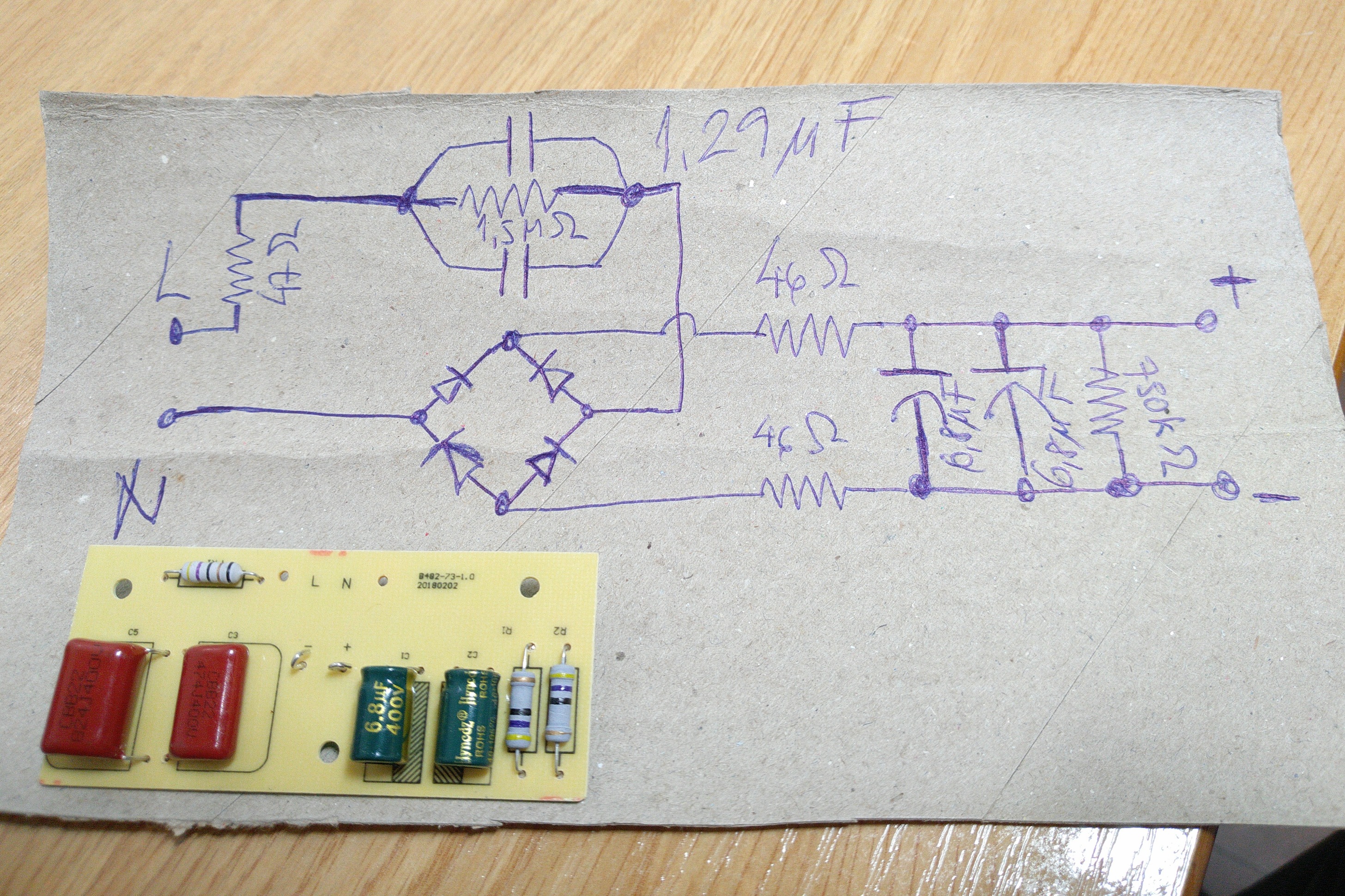
There current delivery depends on input frequency times capacity. I wonder how this concept could be of help in low voltage drivers… probably not much. They really saved on such a driver, and guess it was not meant to break, by the way.
I suppose noise yes, the op-amp is precise enough, very low offset voltage (max10uV) and input curent bias so I think it’s not that, I don’t know what is the sense voltage in the new FF lights, it’s 60mV I believe in the lume1, 50mV in the KR4 driver (linear, but also have unreliable 1st and 2nd levels). So it would seem that 50~100 uV sense voltage is too low. I mentioned 1:65000 in the specs, that is 8bit on each ranges, with a 40mV sense voltage (5A, 8mΩ) that means 150uV at 1/255 and which should be high enough to avoid any problems. It would generate 200mW of wasted power at the max current which is quite low already, but it could be lowered further with a lower sense resistance, at the cost of resolution.
I love this forum.
Following
